One such scholar was an English Jew named Isaac Delgado, who published his New Translation of the Pentateuch Being a Thorough Correction of the Present Translation, Wherever it deviates from the Sense of the Hebrew Expressions, or where it renders obscure the Meaning of the Text ; or, lastly, when it occasions a seeming Contradiction ; Proving the Validity of such Emdendations by Critical Remarks and Illustrations, Grounded on other Instances in Scripture where the like Words of Phrases occur : Together with a Comment on Such Passages as cannot be sufficiently understood by a mere Translation. Being a Work highly useful, and never before attempted (London, 1789).
His qualification is written by him on the title page: "Teacher of the Hebrew language." The subscription lists about 166 names, mostly Jewish, but with a significant percentage of Christians as well. The subscribers are English and Dutch. One interesting entry is the Society of Talmide Sadic in the Hague. There are two or three female subscribers and, interestingly, the name of no rabbi (whom I can identify) appears. There are a few middle to low-level familiar names, but they don't get more famous than Granville Sharp or Levy Alexander. There's no Thomas Jefferson here.
In the introduction he explains why he wrote this work. His reason amounts to a variation of במקום שאין אנשים השתדל להיות איש, or, "in a place without men, strive to be a man." He writes that even though many Bibles promise corrections on the title page, really they only make a few corrections, and usually leave the real difficulties untouched. He is well aware that doing it properly is difficult and, in reality, probably beyond the ability of one person. This may be the reason why others have neglected it. "However," writes Delgado, "I conceive that it is every man's duty, who is a proficient in the Hebrew language, to begin such a work, and proceed, as far as his abilities will permit him, in correcting the several errors in the present translation."
He lists 8 causes of difficulty in translating the Hebrew Bible, one of which I'll give here. He refers to the fact that in Biblical Hebrew it is not uncommon for letters to be transposed in words. For example, both כבש and כשב mean lamb. In Psalm 76:5 - he gives it as verse 4, since it is verse 4 in the KJV - the verse reads נאור אתה אדיר מהררי טרף, which is translated as Thou art more glorious and excellent then the mountaines of pray. Delgado contends that the Hebrew נאור means to say נורא, or "terrible ; for, with what propriety can glory or beauty be compared to mountaints of prey?"
He blames the "many seeming contradictions and absurdities" on translators not paying attention to the 8 rules. He defends the Masoretic text, writing that if after consulting all the commentators he still cannot explain something, he will leave it unexplained rather than
"avail [him]self of that pernicious method of supposing an error in Scripture, committed by transcribers after the compilation of the Bible by Ezra and his synod, who faithfully handed it down to us as they found it, without venturing to alter a single letter, and was since preserved by the Massorites as pure as they received it, which will be proved by my observations on Joshua chap. xxi. ver 36. And it is worthy of notice, that all over the world, wherever there is a congregation of Jews, there is not any material difference in their Hebrew Bibles. But, to pretend to correct the original Hebrew by the different readings found in manuscripts lodged in private hands, which may have received many alterations by being copied from other manuscripts, (in which some annotations, having been interlined, may have been introduced into the text,) I think it prophane, as it would give us a spurious copy, instead of a divine narrative. However, I cannot deny that there are some apparent errors in Scripture, but am firmly persuaded that they have been so ab origine, I mean before the compilation of the Bible by Ezra, and not committed since by transcribers : but this refers only to the rest of the Bible, exclusive of the Pentateuch, which was written by Moses; - therefore I cannot admit of any error in it : besides, they are kept in the synagogues to be read weekly ; and every copy is carefully examined, that there be not a letter too much nor any missing in it ; and, if an error is found at the time of its being read, it is laid aside, and another is taken out, and the first is given to a scribe to correct it : so that it seems to me almost impossible that there should be any error in it : whereas, the other parts of the Bible, we do not know to a certainty who wrote them ; for, several of those books were certainly not written by those whose names they bear."
To me this lengthy paragraph almost reads like he had really only wanted to write that he believes the Masoretic text is sound, but passion would not allow him to rest his pen. It is a lengthy polemic against Benjamin Kennicott, and the tendencies he represented. He continues in this vein, arguing that even though he agrees that in the biblical books besides for the Pentateuch there may be errors, but only errors from before the time of Ezra, nevertheless he is not even sure that they were mistakes. Rather, he inclines to think that they were purposely introduced into the text to indicate certain information apart for what the text itself says, even if with the passage of so much time we may not be able to know what extraneous information was intended.
He then goes on to contradict himself by supplying a possible example of what he meant from the Pentateuch, Gen. 23:1, where the term חַיֵּי שָׂרָה, "the life of Sarah," appears at the beginning and end of the verse. He explains that this seemingly insignificant repetition might be intended to convey other information, such as Isaac's age when sacrificed, and the date of Rebecca's birth, since these two seemingly unrelated events were related in the prior chapter. If this is so, the verse can be understood in the following way: "Then (referring to the two events) the life of Sara was an hundred years, (of course, Isaac was ten years old, and Rebecca was then born,) and twenty-seven years (more) were the years of the life of Sara." If so, then the first "life of Sarah" refers to her age at 100, and the latter "life of Sarah" refers to her whole life, aged 127 years. This is an interesting interpretation in its own right, somewhat reminiscent of a traditional Jewish interpretation which also sees the binding of Isaac and Rebecca's birth as simultaneous events. However, traditionally Sarah also died then. This meant that Isaac was 37 years old at the time of the binding, which is difficult, as is the idea that he was 37 years older than Rebecca, whom he married. Yet in Delgado's interesting and somewhat ingenious interpretation, Isaac was only 10 years old at the binding, and only 10 years older than Rebecca. However, in his view Sarah lived another 27 years, and it seems fairly clear that she was dead already when Isaac married If you ask me, it is hard to explain why Isaac waited to marry Rebecca until she was 27 (and he was 37). However, if you look at the text closely, you'll notice that Abraham remarries Keturah in the chapter after Isaac marries Rebecca. Did Delgado think that Sarah was still alive when Isaac married? If you thought he clarifies any of this in the body of the book proper, you'd be mistaken. However, I think I can prove he did think Sarah was still alive. In a complicated calculation he explains that Isaac had been married already 20 years in the year 2086, when his sons were born, and that Abraham died in 2121 aged 175. That means Isaac married in 2066, when Abraham was 120. That means Sarah was then 110. So she has 17 more years alive. What a pity, since Sarah missed the birth of Esau and Jacob by only three years. This means then that according to Delgado, what actually happened was that 20 year old Isaac married 10 year old Rebecca.
Finally, recall that his interesting example doesn't explain the errors which he admits can be found all over the Bible, apart for the Pentateuch, and which may be explained as hinting at additional information.
Readers will note that he promised to give an explanation for why and how he contends that the Masoretic text was transmitted very exactly in his note to Joshua 21:36. Unfortunately this was the only book he produced, so I have no idea what he intended to say, although it obviously has to do with the two verses missing here in the Masoretic text, which appeared in some Hebrew texts and in the KJV, following the Septuagint.
Here is the Radak, printed in the 2nd Rabbinic Bible. As you can see, he points out that although these verses are paralleled in 1 Chronicles 6:63-64, the Masorah omits it here:
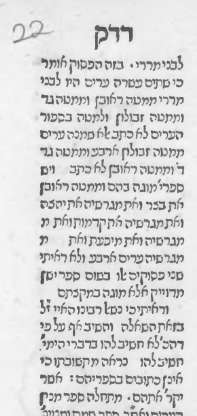
Readers who are interested should know these verses are simply missing in the Aleppo Codex and other Masoretic sources. The 2nd Rabbinic Bible omits them as well. To this day, some Hebrew Bibles print them at the bottom, or in parentheses, but all follow the Masorah and maintain that they do not really belong here. By contrast, Christian Bibles generally print the verses. See the end of this post for a note in one such edition.[1] Getting back to Delgado, at the very end he writes that he wishes to print three more volumes, which will contain the entire Hebrew Bible. He claims it is already written, just waiting subscribers and the press. If so, then his observations on this verse might exist in manuscript somewhere. Just saying.
Now, his book isn't really a new translation per se. Instead, it lists the "Old Translation" in a parallel column with the "New Translation." The New gives a verse of phrase where he differs from the KJV, with the differences printed in italics. Below the two columns is a section called Observations, where he explains and justifies his proposed translation. For example, in the very first verse, he gives the Original as In the beginning God created the heaven and the earth. His New Translation is In the beginning God produced the heavens and the earth. We see two changes. The first is to render heaven in the plural, and the second is to change created to produced. His Observations is a little philological and a little philosophical. He explain that the word ברא signify the production of something which only has the appearance of being. As an example, he notes (claims) that evil is not an actual thing, but the absence of goodness, just as darkness is the absence of light. Yet Isaiah 45:7 expresses this negative existence in terms of ברא, or God's producing evil (and darkness). Since the heavens and earth were not created until the second day, it must mean that whatever it is that God did here, it was not created. Rather, he produced the heavens and earth. Delgado does not note that he changes heaven to heavens, but he is simply rendering the Hebrew shamayim into a plural in English, which is perhaps justifiable.
To me, a far more interesting example is found way at the end. Deuteronomy 33:2 in the Hebrew contains a big obscurity, namely אשדת למו, which the Masorah breaks into the words אש דת למו, or a "fiery law unto them." Were the keri not "esh das" then presumably the unpointed אשדת would be read "ashedos," which is a fine biblical Hebrew word, meaning slope, or perhaps waterfall (derived from אשדה). Indeed, many modern Bibles translate here according to the kesiv אשדת.
An additional problem is that דת is a word which only appears in the late biblical books, and appears to be Persian. Thus, the keri actually raises the question of how, if the Torah is the oldest books in the Bible, it contains a word which otherwise does not occur in the Torah, and doesn't even occur until the very last books.
In any case, before I get to Delgado, here is an appropriate moment to quote Rabbi Aryeh Kaplan in his The Living Torah (New York/ Jerusalem, 1979), who translated it as "From the holy myriads, He brought the fire of a religion to them from His right hand." His note indicates that he is translating according to Rashi and Ibn Ezra. He gives several other renderings: "Fire becomes law" (Hirsch), "a law of fire" (Ramban), or "a Torah of light" (Saadia). Artscroll, incidentally, translates "a fiery Torah," and speaks in its silence by not even gently calling attention to what Kaplan does forthrightly, namely the following:
"Some see eshdath as a single word, indicating a waterfall as in Numbers 21:15, above 3:17 (Eliahu Levitas [! sic]; cf. Ibn Janach who rejects this), and hence, "from His right hand a waterfall to them." He also offers three additional interpretations, the Targum, Septuagint and Abarbanel.
First of all, when I first read this it blew my mind. Not that Kaplan called Eliyahu Levita "Levitas," but that he claims that he - Rabbi Eliyahu Bachur - interpreted it as one word. That's amazing. Could there be a Jewish exegete (or, really, Hebraist) in the 16th century who openly maintained that the pshat in the word was according to the kesiv and not the keri? Furthermore, why didn't I already know it? You'd think this would be famous.
Now, I knew that Shadal takes the only liberty he allowed himself with the Torah, to occasionally interpret it against the Masorah, and he gives this precise explanation. He translates this word "pendice," or "slope." In his Hebrew commentary he explains that "from the right" refers to the slope of the mountain, which Moshe was standing upon right then - Nebo. He goes on to explain why it is from the right, namely because Sinai, Seir, and Paran are all to the south of Nebo, and the south is termed "yamin," or right, in biblical Hebrew. He explains that he rejects the explanation that Moshe was referring to Sinai, rather than Nebo, because then the verse would not have begun with "mi-sinai ba," but "al Sinai," so therefore the verse was not speaking of the Revelation at Sinai, and it certainly is not referring to God's right side. He then explains why he also cannot translate according to the keri: the word das is not Hebrew, or even Aramaic - it's Persian. Furthermore, in his view, the cantillation does not support the keri. Although he does not say it, he obviously feels that the keri is a kind of Midrashic explanation, and not really the Torah's intent. When you compound that with the problem that the presence of a Persian word has unattractive implications for the Mosaic authorship of this verse, he rightly - according to the situation in which he finds himself - translates and interprets according to the kesiv.
But this is a 19th century explanation. Did any Jew suggest it in the 16th? So, again, I was astonished to learn that Levita should interpret it the same way. After searching his books, in expected and unexpected places, and after inquiring of a very expert scholar, I concluded that Kaplan is mistaken. My guess is that he meant Shadal. I think he confused them because Shadal is closely identified with the famous position of Levita (Bachur) that the vowels and accents were written down very late, in fact after the compilation of the Talmud. But I digress.
==
2.17.2011 Important update regarding the above, please see end of post.
==
How does Delgado interpret this verse?
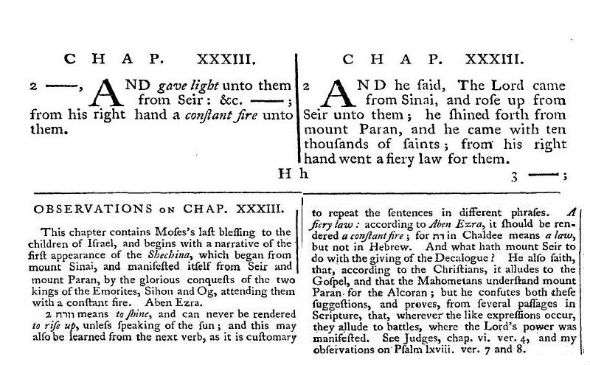
As you can see, he translates it as "a constant fire," on the authority of Ibn Ezra. Delgado notes that das does not mean law (or Torah) in Hebrew, although he errs - though understandably - in seeing it as having that meaning in Chaldee, or Aramaic. Ibn Ezra explained that das comes from omedes, that is, the fire is omedes tamid, or burning constantly. To be sure, Ibn Ezra initially interprets the words as referring to the Torah, which was given amidst fire and thunder.
I think what you see here is kind of a transitional type of interpretation. Traditionalist, but not entirely. Delgado knows that das as Torah is unlikely. Yet he will not interpret against the Masorah, so he latched onto an alternate explanation which is sort of traditional, yet does not require him to explain das as law. It should be noted that in the late 18th century there was a scholarly rebellion against explaining this according to the keri, a fiery law (the KJV originally read "a fierie Law.") For example, embodying both tendencies which Delgado opposed, Kennicott in 1753 had devoted several very interesting pages to the difficulty of this phrase, remarking that the verses are "remarkably unintelligible." He therefore suggests "the following Correction:"
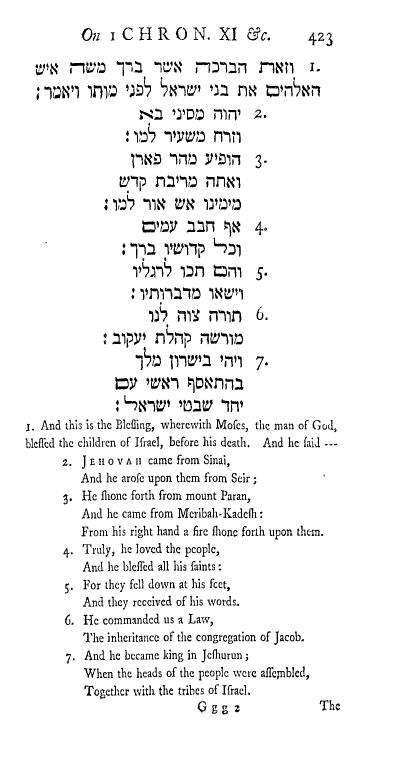
As you can see, אשדת למו has disappeared, no more אשדת and no more אש דת. Instead we see אש אור, and he translates it as "a fire shone forth" (among other emendations). Kennicott also claims that the word das is Chaldee, and that frankly the phrase esh das really doesn't make much sense. He further notes that in verse 4. the word torah is used. In addition, neither the Septuagint nor the Peshitta translate it this way. He then gives parallel parts of Scripture where light is streaming from the hand of God. Finally, he builds his case with Samaritan text. First he notes that in some manuscripts the word is written דות, (this is of interest - he downplays it, but the point is that in the Samaritan texts the word is separated into אש דת, according to the keri of the Masoretic text). Secondly, he cites the Samaritan Targum which translates the phrase as מימינה נור אורה גון, which for his purposes is the same as he wants to translate it. How to tease the Hebrew אור out of נור אורה, which after all means fire and light, same as אש? In other words, how to show that this isn't only an interpetive translation, but can be shown to stem from an original uncorrupted Hebrew text? The key is דות, which he contends is not just an odd error, but a very special one. There is no way to explain that extra vav, except as follows: it is a remnant of the original, uncorrupted word which was אור. However, the first and third letters were corrupted. The tav is very similar to resh in the (Jewish!) Hebrew alphabet, which can plausibly explain the substitution of at least one of these letters. Thus, esh or lamo.
By the way, how should we understand these Samaritan manuscripts which write דות? In my opinion, very simply. The Samaritan text has no nekudos, and if das is a unique word in the Jewish Torah, at least it appears in other books in the Bible, meaning law. The Samaritans have no other books, thus they do not have the word das in their Bible, except for right here. How are Samaritans supposed to understand אש דת? Well, we have the Samaritan Targum mentioned by Kennicott. That's one way. Another way is אשדת, as one word (even though it is separated into two in their text, at least according to Kennicott and Blayney). Since they have no points, the insertion of a vav hints that it should be read ashdos, or אשדות. Thus, in my opinion, these variant Samaritan texts are interpreting themselves, to mean slope.
In a letter written early in 1773 to a like-minded contemporary, Moses Mendelssohn alluded to Kennicott with this very example, as typical of the decadence of biblical emendation in his time.
"Who is supposed to buy a rabbinic commentary in our clever age, when every student of Hebrew is permitted to change the text at will? If . . . [another example] seems incomprehensible, an English reviser is immediately at hand who reads [an emendation], and rabbinic skills are no longer needed. Is 'esh dat lamo difficult to explain? No problem. Read 'or instead of dat and everything is clear. I do not know where this audacity will end." (Translation by Alexander Altmann on pg. 286 of his Mendelssohn biography.)Mendelssohn continues by saying that one must allow a fashion to run its course, for novelty is alluring. Eventually people will lose their taste for it, and then they may be led back to the path of sound reason. Here is his letter, from the 5th volume of his Gessamalte Schriften:
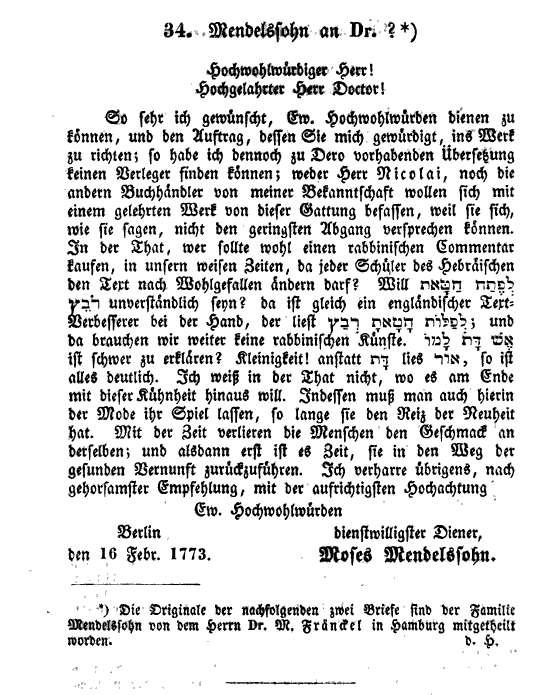
Not surprisingly, in his own version of the Bible, Mendelssohn translates esh das as Feuerslutreligion (פייארסגלוטרעליגאָן ; isn't German gorgeous?).
A contemporary and sometime correspondent of Mendelssohn, the Bible scholar Michaelis, translated as "Rechten Wassergüsse," or a waterfall to his right:
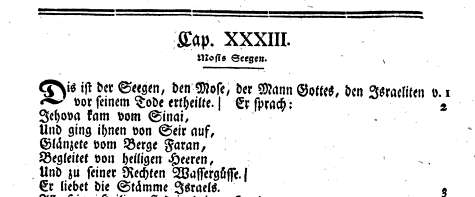
Incidentally, in my opinion Michaelis got carried away with the fact that the word ashedos could mean waterfall, but over here, does it? Which waterfall? It's beautiful poetry, but so is esh das, a fiery law.
Incidentally, the following is a very interesting treatment, written by Ignaz Goldziher and his teacher Heymann Steinthal. In the English translation of their work, "Mythology among the Hebrews and its historical development," we find the following:
"If the reading esh dath in the Blessing of Moses v. 2 is correct, the word dath points to a society accessible to Persian words; and the passage in Deut. XXXII. 39, where the doctrine of the resurrection of the dead is mentioned as a recognised article of faith, confirms this impression."
This book was written in refutation of bible critics, particularly Renan, who had denied the existence of Hebrew mythology. What do you mean we had no mythology? asked this work. I'll give you mythology! Secondly, although I am not sure this is intended, it perfectly illustrates the problem Shadal had with interpreting it as two separate words. Goldizher and Steinthal spell it out clearly. "If" the reading is correct then "the word dath points to a society accessible to Persian words." They do not say it, but if the reading is not correct, then it doesn't point to it at all. (Goldziher may not have really believed the Torah was written by Moshe, but he definitely knew how to observe Tisha B'av; see here.)
Finally, the 2009 paper jointly published by Richard Steiner and Sid Z. Leiman, The Lost Meaning of Deuteronomy 33:2 as Preserved in the Palestinian Targum of the Decalogue, must be mentioned. In this paper it is argued that esh dat (whether together or separate) is the correct original reading, but never meant a fiery law. This, rather, was the midrashic interpretation. The argument is that דת is a contraction of דאת, an archaic term meaning "flew." Thus the original peshat was "fire flew," and this had become forgotten when "דת was midrashically identified with the homonymous Aramaic loanword of Iranian origin meaning 'law.'
[1] The aforementioned note on Joshua 21:36-37, from the "Keil and Delitzsch Biblical Commentary on the Old Testament":
Note: R. Jacob ben Chajim has omitted Joshua 21:36 and Joshua 21:37 from his Rabbinical Bible of the year 1525 as spurious, upon the authority of Kimchi and the larger Masora; but upon insufficient grounds, as these verses are to be found in many good MSS and old editions of an earlier date than 1525, as well as in all the ancient versions, and could not possibly have been wanting from the very first, since the Merarites received twelve towns, which included the four that belonged to Reuben. In those MSS in which they are wanting, the omission was, no doubt, a copyist's error, occasioned by the homoioteleuton (see de Rossi variae lect. ad loc., and J. H. Michaelis' Note to his Hebrew Bible).
2.17.2011 Important update: Moshe Maimon informs me that I overlooked a very important source - Levita's notes to Kimchi's Shorashim! This is from the 1547 edition:
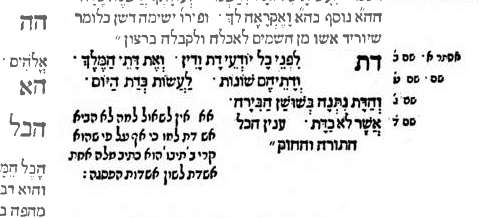
As you can see, he does indeed say - or rather imply - that the word is really "ashdos." This is his explanation for why the Radak (Kimchi) did not cite Deut. 33:2 as a source for the word das.
Thus, I was mistaken and Rabbi Aryeh Kaplan correctly points to him. It would seem then that R. Eliyahu Bachur understood that "esh das" is really Midrashic, and if he is right, so did the Radak - the other possibility simply being that the Radak would understandably only write words written in the Bible, and "esh das" is only read. Perhaps this is all he meant as well.





great post. I always wondered about that phrase. Now I will keep on wondering knowing it will never yield any definitive translation.
ReplyDeleteRichard Steiner has an article where he reads it as a version אש דאת, "fire flew". As in the דאה, the "swooping bird".
ReplyDeleteI mentioned it. (the follow up article, actually).
ReplyDeleteLoved the post. And bonus points to the "fire flew" reading, as we have "yid'eh hannasher" also in Dvarim.
ReplyDeleteOh, I see. You call him "Steinman".
ReplyDeleteFunny. Wonder why I did that?
ReplyDeleteI wonder when or where Aryeh Kaplan read Elijah Bahur's notes on Qimhi!
ReplyDeleteKaplan was a bibliophile. He actually wrote a beautiful, inspirational article about it in the Jewish Observer. For example, he wrote about how it was still possible (late 70s) to find a leaf from an incunabulum in the seforim stores of the Lower East Side. I'm sure he went to the NYPL, or JTS, or Chabad or wherever to do research. I once counted over 300 sources in his Living Torah bibliography. I'm not saying he was a critical scholar, but you thought he was just an NCSY hack, right? ;-)
ReplyDeletebut you thought he was just an NCSY hack, right? ;-)
ReplyDeleteYes. And a physicist. (Though Wikipedia tells me that he had no more than an MA in physics -- I thought more than that.)